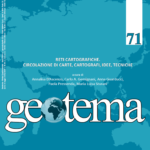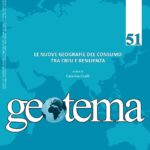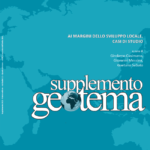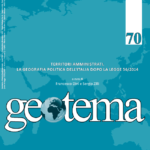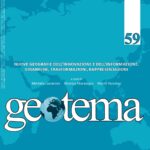Giorgia Bressan
Fotografie aeree e processi di territorializzazione. Considerazioni sulle recenti trasformazioni della Campagna Romana tra la Via Nettunense e l’Agro Romano
I Castelli Romani sono conosciuti come area di fitto insediamento che si sviluppa principalmente lungo le maggiori arterie viarie, dove tuttavia si ritrovano ampie zone ad alto valore naturalistico e culturale ricadenti nell’area protetta del Parco Regionale del Castelli Romani. Anche l’area a sud-ovest della Via Appia viene riconosciuta già negli anni Ottanta come soggetta ad un intenso processo di urbanizzazione. In tale contesto, significative discontinuità rispetto al fitto tessuto edilizio sono offerte non tanto dal patrimonio naturalistico del Parco, ma dalla presenza di un circolo golfistico privato e dai paesaggi della Campagna Romana. In questo contributo si vogliono analizzare le trasformazioni occorse in questo contesto geografico e discuterne le sue caratteristiche passate e odierne. Servendosi di varie fotografie aeree del Novecento, si vuole riflettere sulle dinamiche dello sviluppo edilizio, sulla permanenza del paesaggio agrario e, infine, sul ruolo del campo
da golf come presidio del territorio. La recente decisione ministeriale di tutelare l’area con una dichiarazione di notevole interesse pubblico è un chiaro segnale della volontà di conservare le qualità fondamentali di questo contesto, nonostante siano già presenti alcuni elementi di compromissione.
Aerial Photographs and Territorialization Processes. Considerations on the Recent Transformations of the Campagna Romana between the Via Nettunense and the Agro Romano
The Roman Castles is known as a highly urbanized area, which mainly develops along the leading road arteries. It also contains stretches of land of high natural and cultural value falling within the protected area of the Roman Castles Regional Park. The area south-west of the Via Appia was also already recognized in the 1980s as subject to an intense urbanization process. In this context, the dense building fabric is broken up not only by the naturalistic heritage of the park, but also by the presence of a private golf club and the landscapes of the Campagna Romana. In this contribution,
the aim is to analyze the transformations that have occurred in this geographical context and discuss its past and present characteristics. Using various aerial photographs from the twentieth century, the work seeks to propose reflections on the dynamics of building developments, on the permanence of the agricultural landscape and, finally, on the role of the golf course as bulwark against further urbanization. The recent ministerial decision to protect the area with a declaration of significant public interest is a clear sign of the desire to preserve its qualities, which are already compromised by the existing patchwork of built-up areas.
Parole chiave: Castelli Romani, fotografie aeree, paesaggio rurale
Keywords: Roman Castles, Aerial imagery, rural landscape



